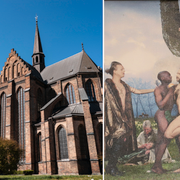
Ny kritik mot tavlan: ”Hör inte hemma i kyrkan”
Ny kritik har väckts mot tavlan ”Paradiset”, av Elisabeth Ohlson Wallin, som i slutet av förra månaden hängdes upp i S:t Pauli kyrka i Malmö, skriver den kristna tidningen Dagen. Det är tidningens egna ledarskribent Joel Halldorf som ifrågasätter om tavlans symbolik är förenlig med Svenska kyrkans teologi. Enligt Halldorf porträtteras ormen i Edens lustgård i ett positivt sken, vilket visar tecken på gnosticism.
Biskopen i Lunds stift, Johan Tyrberg, menar att tavlan bör utredas av det berörda stiftet innan jul.
– En gnostisk tavla hör så klart inte hemma i Svenska kyrkan, men jag har ännu inte gjort en analys, säger han till tidningen.
”Paradiset” har tidigare beskrivits som Sveriges första ”hbtq-altartavla”.
bakgrund
Gnosticism
Wikipedia (en)
Gnosticism (from Ancient Greek: γνωστικός gnostikos, "having knowledge") is a collection of ancient religious ideas and systems which originated in the first century AD among early Christian and Jewish sects. These various groups, labeled "gnostics" by their opponents, emphasised personal spiritual knowledge (gnosis) over orthodox teachings, traditions, and ecclesiastical authority. They considered the principal element of salvation to be direct knowledge of the supreme divinity, experienced as intuitive or esoteric insight. Generally, Gnostic cosmogony presents a distinction between a supreme, transcendent God and a blind, evil demiurge responsible for creating the material universe, thereby trapping the divine spark within matter. Many Gnostic texts deal not in concepts of sin and repentance, but with illusion and enlightenment.Gnostic writings flourished among certain Christian groups in the Mediterranean world until about the second century, when the Fathers of the early church denounced them as heresy. Efforts to destroy supposedly heretical texts proved largely successful, resulting in the survival of very few Gnostic texts. Nonetheless, early Gnostic teachers such as Valentinus saw their beliefs as aligned with Christianity. In the Gnostic Christian tradition, Christ is seen as a divine being which has taken human form in order to lead humanity back to the Light. However, Gnosticism is not a single standardized system, and the emphasis on direct experience allows for a wide variety of teachings, including distinct currents such as Valentianism and Sethianism. In the Persian Empire, Gnostic ideas spread as far as China via the related movement Manichaeism, while Mandaeism is still alive in Iraq.
For centuries, most scholarly knowledge of Gnosticism was limited to the anti-heretical writings of orthodox Christian figures such as Irenaeus of Lyons and Hippolytus of Rome. Renewed interest in Gnosticism occurred after the 1945 discovery of Egypt's Nag Hammadi library, a collection of rare early Christian and Gnostic texts, including the Gospel of Thomas and the Apocryphon of John. A major question in scholarly research is the qualification of Gnosticism as either an interreligious phenomenon or as an independent religion. Scholars have acknowledged the influence of sources such as Hellenistic Judaism and Platonism, and some have noted possible links to Buddhism and Hinduism, though the evidence of direct influence from these latter sources is inconclusive.
Tidigare
Omni är politiskt obundna och oberoende. Vi strävar efter att ge fler perspektiv på nyheterna. Har du frågor eller synpunkter kring vår rapportering? Kontakta redaktionen


